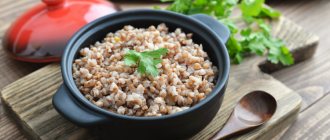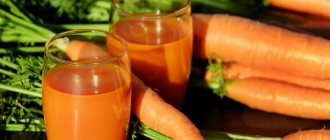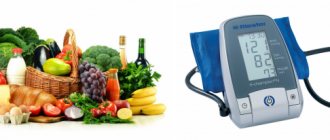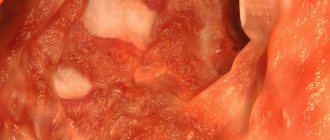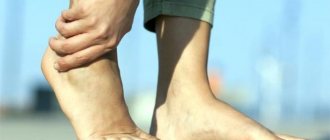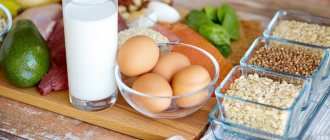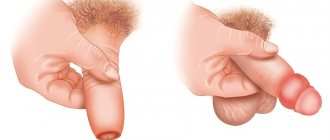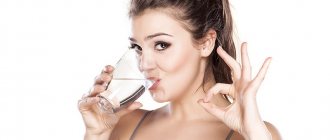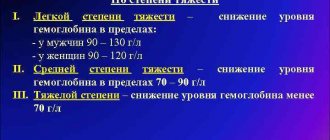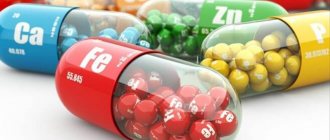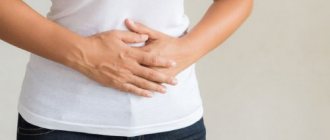General rules
The indirect oral anticoagulant Warfarin is the drug of choice for the prevention and treatment of a number of thrombotic complications. As a rule, the drug is prescribed for a long period. vitamin K antagonist , is considered to be the “gold standard” of the group of indirect-acting anticoagulants due to its relatively low toxicity, rapid onset of action and short aftereffect. Refers to monocoumarin .
The mechanism of its action is based on the blockade of one of the stages of the synthesis of vitamin K-dependent blood coagulation factors - VII, IX, X, and II ( prothrombin ), the synthesis of which is carried out by liver cells, which leads to hypocoagulation and weakening of Ca2+ dependent reactions in the coagulation mechanism blood and prevents the formation of thrombin and, accordingly, the development/progression of arterial/venous thromboembolism.
Anticoagulant therapy with indirect oral coagulants is prescribed for acute venous thrombosis, cardiac arrhythmias ( atrial fibrillation ), pulmonary embolism , thrombosis of the coronary, peripheral and cerebral arteries, myocardial infarction , postoperative thrombosis , thrombophilia , and the presence of prosthetic heart valves.
An important feature of prescribing the drug is the need for precise dosage, since incorrect administration/overdose of Warfarin can cause side effects of varying severity, including acute internal bleeding with a fatal outcome. Therefore, when using Warfarin, constant monitoring of blood parameters (in particular INR) and diet is necessary, since it is food containing a lot of vitamin K that weakens the effect of the drug and increases the risk of complications.
The diet when taking Warfarin is based on the principles of rational nutrition and is aimed at maintaining a constant amount of vitamin K in the diet. That is, you should not suddenly change your usual diet, including increasing/limiting foods containing large amounts of this vitamin, since its excess in the body weakens the effect of the drug, and its sharp decrease can enhance the effect of Warfarin.
Therefore, it is important to ensure that the level of vitamin K received daily from food is approximately the same in order to create optimal conditions for the action of the drug, since its dosage significantly depends on the amount of vitamin K received from food. And for this you need to be well versed in the content of vitamin K in food and in the daily diet in general.
Its maximum amount is found in dark green leafy vegetables/herbs (green cabbage, amaranth greens, avocado, spinach, coriander-cilantro leaves, cucumber peel, parsley, kiwi fruits, lettuce, mint), and in green tea. An intermediate amount is found in pale green plants (Brussels sprouts, broccoli, lettuce), as well as in legumes and mayonnaise.
In vegetable oils, its content varies depending on the type of oil - more is found in soybean, olive, and rapeseed oil. In baked goods, dairy and meat products, mushrooms, black tea/coffee, its content is relatively low. The table below gives some idea of this.
| Product Name | Amount of vitamin K in mcg/100 g of product |
| Spinach leaves | 415 |
| Soybean oil | 193 |
| Watercress | 205 |
| Broccoli | 175 |
| Green tea | 700 |
| Cauliflower | 85 |
| Beef liver | 93 |
| Butter | 32 |
| Hard cheeses | 35 |
| Green tomatoes | 80 |
| Beans | 45 |
| Potato | 16 |
Proper nutrition when taking Warfarin can be based on the principles of therapeutic dietary Table No. 10 . Soups are vegetarian. As protein products, it is recommended to include low-fat fish, dietary poultry and rabbit in the diet. Preferably boiled/steamed meat without skin or visible fat. Vegetable fats are preferred - any unrefined virgin oils and unsalted butter in an amount of no more than 30 g / day.
Among carbohydrates, preference is given to products containing complex carbohydrates - porridge cooked in water, whole grain pasta, dried rye bread. Boiled potatoes and diet bread are allowed. The main sources of fiber should be your usual types of greens and vegetables/fruits. It is also allowed to eat a boiled/soft-boiled egg (one per day) and include sauces based on dairy products in the diet.
There is practically no limit on fermented milk products with low fat content. Drinks include rosehip decoction, weak black tea, pure water, fruit compotes from sweet fruits. Meals are fractional.
When taking Warfarin, it is necessary to exclude white bread, pastries, puff pastry and products made from it, cakes, biscuits, and cookies from the diet. You should avoid fatty red meat and poultry, as well as fatty sausages, smoked meats, canned food, fatty fish, concentrated meat/fish broths, animal and cooking fats.
It is especially important not to include in the diet if they were not previously present in the list of products: spinach, sorrel, radishes, cabbage of various types, daikon, garlic, radish, cilantro, parsley, kiwi fruits, avocado, green tea or maintain their use in those the same quantities as before starting Warfarin.
Salty/fatty cheeses, fried/hard-boiled eggs, legumes, mushrooms, pickled, salted and pickled vegetables, fruits with coarse fiber, natural coffee, chocolate, cocoa, and alcoholic beverages are limited. Any fried food is excluded. Salt intake is 5-7 g/day.
It is important to monitor the intake of multivitamins containing vitamin K. Regular consumption of cranberry berries/juice can also potentiate the effect of the drug. Quinine, which is part of a number of tonic drinks, also has the ability to enhance the effect of Warfarin.
Some medicinal plants can also both enhance the effect of Warfarin (gingko biloba, garlic, angelica, papaya, sage) and reduce its effectiveness - ginseng and especially St. John's wort and its preparations.
At the same time, the effect of inducing the action of Warfarin persists for another 2 weeks after the end of the course of taking St. John's wort-containing drugs.
Recommendations for atrial fibrillation
In addition to eliminating or limiting the consumption of foods that affect the action of Warfarin, the diet for atrial fibrillation should include the following principles:
- It is recommended to choose whole grains instead of simple carbohydrates.
- It is necessary to monitor the glycemic index of foods and add predominantly non-starchy vegetables and fruits with low sugar content to the menu.
- Protein sources should be consumed every day, and it is advisable to opt for fish and poultry rather than red meat.
- Use only healthy fats such as olive, coconut and grapeseed oil.
- Sources of caffeine, alcohol and spicy salty snacks (kimchi, Korean salads, pickled hot peppers) should be completely eliminated or limited as much as possible.
- Consumption of processed foods, sugar and carbonated drinks should be minimized.
Authorized Products
The diet when taking Warfarin includes:
- Lean dietary meat (without skin) turkey, chicken, rabbit, lean beef, beef liver.
- Various types of sea/river fish (mackerel, herring, hake, mackerel, salmon, sturgeon, sardines, pike, carp, perch), seafood (shrimp, crabs, mussels, oysters, squid), fish oil and various types of seaweed.
- Virgin vegetable oils (olive, cottonseed, corn, sunflower) and other products containing unsaturated fatty acids - nuts, flax seeds, dried fruits, seeds.
- Cereals in various forms (bread, porridge, sprouted grains of wheat, rye, whole grain bread).
- Fermented milk/low-fat dairy products (cottage cheese, kefir, acidophilus milk, natural yogurt).
- Various types of vegetables/fruits that do not contain much vitamin K - bell peppers, zucchini, jacket potatoes, carrots, tomatoes, onions, sauerkraut, citrus fruits, apples, cherries, apricots, strawberries, black currants, gooseberries, which are allowed to be consumed in various forms.
- To drink - rosehip decoction, herbal teas, still mineral water, freshly squeezed juices from permitted vegetables/fruits, weak black tea, jelly, compote.
Table of permitted products
| Proteins, g | Fats, g | Carbohydrates, g | Calories, kcal | |
Vegetables and greens | ||||
| boiled cauliflower | 1,8 | 0,3 | 4,0 | 29 |
| boiled potatoes | 2,0 | 0,4 | 16,7 | 82 |
| canned grape leaves | 4,3 | 2,0 | 11,7 | 69 |
| carrot | 1,3 | 0,1 | 6,9 | 32 |
| cucumbers | 0,8 | 0,1 | 2,8 | 15 |
| salad pepper | 1,3 | 0,0 | 5,3 | 27 |
| boiled beets | 1,8 | 0,0 | 10,8 | 49 |
| tomatoes | 0,6 | 0,2 | 4,2 | 20 |
| dill | 2,5 | 0,5 | 6,3 | 38 |
| garlic | 6,5 | 0,5 | 29,9 | 143 |
Fruits | ||||
| apricots | 0,9 | 0,1 | 10,8 | 41 |
| oranges | 0,9 | 0,2 | 8,1 | 36 |
| cherry | 0,8 | 0,5 | 11,3 | 52 |
| grapefruit | 0,7 | 0,2 | 6,5 | 29 |
Berries | ||||
| cranberry | 0,5 | 0,0 | 6,8 | 26 |
| gooseberry | 0,7 | 0,2 | 12,0 | 43 |
| Rowan | 1,5 | 0,1 | 10,9 | 50 |
| rose hip | 1,6 | 0,0 | 14,0 | 51 |
Nuts and dried fruits | ||||
| sesame | 19,4 | 48,7 | 12,2 | 565 |
| dried apricots | 5,2 | 0,3 | 51,0 | 215 |
| prunes | 2,3 | 0,7 | 57,5 | 231 |
Cereals and porridges | ||||
| buckwheat (kernel) | 12,6 | 3,3 | 62,1 | 313 |
| cereals | 11,9 | 7,2 | 69,3 | 366 |
| Wheat groats | 11,5 | 1,3 | 62,0 | 316 |
| wheat bran | 15,1 | 3,8 | 53,6 | 296 |
Bakery products | ||||
| whole grain bread | 10,1 | 2,3 | 57,1 | 295 |
Confectionery | ||||
| jam | 0,3 | 0,1 | 56,0 | 238 |
Raw materials and seasonings | ||||
| honey | 0,8 | 0,0 | 81,5 | 329 |
Dairy | ||||
| kefir 3.2% | 2,8 | 3,2 | 4,1 | 56 |
| sour cream 15% (low fat) | 2,6 | 15,0 | 3,0 | 158 |
Cheeses and cottage cheese | ||||
| cottage cheese | 17,2 | 5,0 | 1,8 | 121 |
Meat products | ||||
| lean pork | 16,4 | 27,8 | 0,0 | 316 |
| beef | 18,9 | 19,4 | 0,0 | 187 |
| beef liver | 17,4 | 3,1 | 0,0 | 98 |
| calf liver | 19,2 | 3,3 | 4,1 | 124 |
| mutton | 15,6 | 16,3 | 0,0 | 209 |
| rabbit | 21,0 | 8,0 | 0,0 | 156 |
| beef stew | 14,1 | 17,4 | 0,0 | 214 |
Bird | ||||
| chicken liver | 20,4 | 5,9 | 1,4 | 140 |
| turkey | 19,2 | 0,7 | 0,0 | 84 |
| turkey liver | 19,5 | 22,0 | 0,0 | 276 |
| goose liver | 15,2 | 39,0 | 0,0 | 412 |
Eggs | ||||
| chicken eggs | 12,7 | 10,9 | 0,7 | 157 |
Fish and seafood | ||||
| brown algae | 1,7 | 0,6 | 8,3 | 43 |
| pink salmon | 20,5 | 6,5 | 0,0 | 142 |
| Red caviar | 32,0 | 15,0 | 0,0 | 263 |
| cod roe | 24,0 | 0,2 | 0,0 | 115 |
| pike caviar | 17,3 | 2,0 | 0,0 | 87 |
| squid | 21,2 | 2,8 | 2,0 | 122 |
| shrimps | 22,0 | 1,0 | 0,0 | 97 |
| salmon | 19,8 | 6,3 | 0,0 | 142 |
| mussels | 9,1 | 1,5 | 0,0 | 50 |
| seaweed | 0,8 | 5,1 | 0,0 | 49 |
| herring | 16,3 | 10,7 | — | 161 |
| cod (liver in oil) | 4,2 | 65,7 | 1,2 | 613 |
| trout | 19,2 | 2,1 | — | 97 |
Oils and fats | ||||
| vegetable oil | 0,0 | 99,0 | 0,0 | 899 |
| butter | 0,5 | 82,5 | 0,8 | 748 |
| olive oil | 0,0 | 99,8 | 0,0 | 898 |
| * data is per 100 g of product | ||||
Blood INR - what is the norm?
How do doctors determine blood's ability to clot?
To do this, a blood test is performed - prothrombin time. Previously, doctors received the result of this analysis in the form of prothrombin index (PTI). Currently, all over the world, the laboratory produces the result of a prothrombin time study in the form of INR - international normalized ratio. All healthy people not receiving warfarin have an INR within one (0.9-1.1). As blood clotting time increases, the INR value increases. For example, to prevent thrombosis in chronic atrial fibrillation, it is necessary to lengthen the coagulation time by 2-3 times. In this case, the INR should be within the therapeutic range of 2.0-3.0. When implanting artificial heart valves, the interval shifts towards greater “thinning” of the blood - from 2.5 to 3.5. Your doctor will tell you what INR goals you need to adhere to.
Fully or partially limited products
The diet when taking Warfarin involves the exclusion of:
- Concentrated meat/fish and mushroom broths.
- Fatty varieties of red meat, smoked sausages, goose and duck meat, canned meat and fish, mayonnaise, bacon, ham, animal/confectionery fat.
- Pickles, marinades, smoked meats, legumes, pasta, white bread, salty and fatty cheeses, baked goods, confectionery and especially with cream, chocolate, fried chicken eggs, fast food.
- Green tea, coffee, cocoa, alcohol-containing drinks.
- High-fat dairy products (cream, sour cream, cottage cheese, baked milk, yogurt with additives).
- Vegetables and fruits of dark green color (cabbage, amaranth greens, avocado, spinach, coriander leaves, cilantro, cucumber peel, parsley, kiwi fruits, lettuce, mint).
- Limit salt intake to 5-7 g/day and salty foods.
Table of prohibited products
| Proteins, g | Fats, g | Carbohydrates, g | Calories, kcal | |
Vegetables and greens | ||||
| canned vegetables | 1,5 | 0,2 | 5,5 | 30 |
Snacks | ||||
| potato chips | 5,5 | 30,0 | 53,0 | 520 |
Flour and pasta | ||||
| vareniki | 7,6 | 2,3 | 18,7 | 155 |
| dumplings | 11,9 | 12,4 | 29,0 | 275 |
Bakery products | ||||
| sliced loaf | 7,5 | 2,9 | 50,9 | 264 |
| buns | 7,9 | 9,4 | 55,5 | 339 |
Confectionery | ||||
| cookie | 7,5 | 11,8 | 74,9 | 417 |
| cake | 3,8 | 22,6 | 47,0 | 397 |
Cakes | ||||
| cake | 4,4 | 23,4 | 45,2 | 407 |
Chocolate | ||||
| chocolate | 5,4 | 35,3 | 56,5 | 544 |
Raw materials and seasonings | ||||
| mayonnaise | 2,4 | 67,0 | 3,9 | 627 |
Dairy | ||||
| milk | 3,2 | 3,6 | 4,8 | 64 |
| cream 35% (fat) | 2,5 | 35,0 | 3,0 | 337 |
| sour cream 30% | 2,4 | 30,0 | 3,1 | 294 |
Cheeses and cottage cheese | ||||
| cheese | 24,1 | 29,5 | 0,3 | 363 |
Meat products | ||||
| fried pork | 11,4 | 49,3 | 0,0 | 489 |
| fatty pork | 11,4 | 49,3 | 0,0 | 489 |
| pork fat | 1,4 | 92,8 | 0,0 | 841 |
| bacon | 23,0 | 45,0 | 0,0 | 500 |
Sausages | ||||
| smoked sausage | 28,2 | 27,5 | 0,0 | 360 |
| smoked sausage | 9,9 | 63,2 | 0,3 | 608 |
Bird | ||||
| duck | 16,5 | 61,2 | 0,0 | 346 |
| goose | 16,1 | 33,3 | 0,0 | 364 |
Fish and seafood | ||||
| fried fish | 19,5 | 11,7 | 6,2 | 206 |
Oils and fats | ||||
| cooking fat | 0,0 | 99,7 | 0,0 | 897 |
| rendered pork fat | 0,0 | 99,6 | 0,0 | 896 |
Alcoholic drinks | ||||
| white dessert wine 16% | 0,5 | 0,0 | 16,0 | 153 |
| vodka | 0,0 | 0,0 | 0,1 | 235 |
| cognac | 0,0 | 0,0 | 0,1 | 239 |
| liquor | 0,3 | 1,1 | 17,2 | 242 |
| beer | 0,3 | 0,0 | 4,6 | 42 |
Non-alcoholic drinks | ||||
| cola | 0,0 | 0,0 | 10,4 | 42 |
| coffee | 0,2 | 0,0 | 0,3 | 2 |
| Pepsi | 0,0 | 0,0 | 8,7 | 38 |
| black tea | 20,0 | 5,1 | 6,9 | 152 |
| energy drink | 0,0 | 0,0 | 11,3 | 45 |
| * data is per 100 g of product | ||||
Menu for the week
When planning a diet, the diet should be developed in conjunction with a professional nutritionist. Below is a sample menu for the week:
Monday
- For breakfast – milk buckwheat porridge, grape juice.
- Lunch – vegetable soup, rye bread.
- Dinner – boiled chicken with a side dish of rice and vegetables.
- Before going to bed, it is recommended to drink fermented baked milk (200 ml).
Tuesday
- Breakfast - a bread sandwich with jam, tea with lemon balm.
- Lunch – chicken cooked in the oven, vegetable salad, black bread.
- Dinner – potatoes with boiled vegetables.
- Before bed – rosehip decoction (250 ml).
Wednesday
- Breakfast – fruit salad with yogurt.
- Lunch – pasta with mild tomato sauce and sesame seeds, juice from a mixture of apple and grapes.
- Dinner – turkey and side dish of corn.
- Before bed - yogurt.
Thursday
- Breakfast – cereal flakes with yogurt.
- Lunch – sea fish with mashed potatoes, dried apricot compote.
- Dinner – vegetable stew with rice side dish.
- Finish the day with a glass of herbal tea.
Friday
- Breakfast – feta cheese (unsalted), grain bread, compote.
- Lunch – salmon fish with vegetable side dish.
- Dinner – vegetable cutlets, herbal tea.
- Before lights out - yogurt.
Saturday
- Breakfast – oatmeal with nuts and dried fruits.
- Lunch – baked salmon slices with a side dish of sprouted wheat grains.
- Dinner – cottage cheese casserole, topped with sour cream.
- Before bed - kefir.
Sunday
- Breakfast – wheat porridge with milk, freshly squeezed orange juice.
- Lunch – mackerel with potato side dish, rye bread.
- Dinner – casserole topped with sour cream.
- You can end the day by drinking a glass of kefir.
The above menu illustrates the principle approach to dietary nutrition. Herbal tea plays an important therapeutic and preventive role. Sugar and salt should be limited as much as possible.
Reviews and results
- “... After hip replacement surgery, thrombosis of the iliac vein developed. Warfarin was prescribed. The doctor said that Warfarin and the diet should complement each other. Received all the necessary recommendations on monitoring the level of vitamin K in the diet and the need to visit the hospital to conduct a prothrombin test using INR. I follow my diet quite strictly, I am more inclined to the Mediterranean diet, I cook for myself. I use a lot of different vegetable oils. I feel fine so far.”
Mode
One cannot think that medication and nutrition prescribed for a long or short-term period will radically change the patient’s eating habits. The task of the doctor and the patient himself is to focus his desires on achieving health and a long life.
From the list of permitted products, you can prepare delicious and healthy dishes that are in no way inferior to culinary delights. Numerous recipes based on dietary foods have appeared on various resources, counting calories and taking into account weight and age.
Divide the daily norm into 5-7 parts so as not to feel hungry. For each snack, count 400 g, which prevents a person from overeating.
Prohibited list
While taking Warfarin, excessive consumption of certain foods and foods may be detrimental to the patient's health.
The list of foods that are recommended to be eliminated from the diet or to minimize their consumption includes:
- High-calorie baked goods with a high sugar content: cakes, butter cookies, puff pastries, as well as bread made from premium flour.
- Canned foods, marinades, pickles.
- Sausages: ham, sausages, fatty kupaty, sausage, both boiled and smoked, half-smoked, raw smoked.
- Chocolate candies.
- Almost all types of cheese, except ricotta (it has low fat content).
- All types of fast food.
- Many varieties of greens: radishes, sorrel, onions, garlic.
- Seaweed, white cabbage.
- Citrus fruits, green unsweetened apples with a high acid content. However, the ban on green apples can be lifted if they are consumed peeled from the hard, tart peel.
- Meat, fish, poultry with a high fat content.
- Excessively fatty dairy and fermented milk products.
- Strong coffee, dark chocolate.
- Cranberries are prohibited both in their natural form and in the form of tinctures and fruit drinks!

